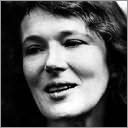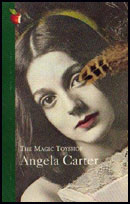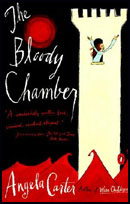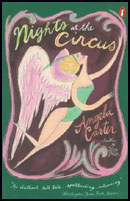Moved Permanently
The document has moved here.

In February, 1992, Angela Carter died at the age of 51. She had published seven novels, numerous short stories and essays, and a meditation on the fiction of the Marquis de Sade. Her work is remarkable for the variety of its genres. Fairy–tale, quest–romance, satire, essay, science fiction, fable, gothic — she used them in turn and in combination, sometimes to tragic ends, more often to comic.
What all of her works share is an exuberant and richly metaphorical prose style, colorful and dangerous characters, a fascination with magic and illusion, an intelligent skepticism about conventional gender roles and divisions, and a breathtaking willingness to take artistic risks. Frequently, Carter seems as reckless as Fevvers, the winged Amazon of Nights at the Circus, whose leisurely flights from trapeze to trapeze dare disbelief, gravity, and common sense. We share with Fevvers' audience the sense that Carter's novels might crash at any moment, feathers and wax everywhere, we knew it was a take–in all along, but, Oh! wasn't it wonderful while it lasted?
Carter brought this brilliance to the service of a number of recurrent themes, several of them at the very heart of Interstitial Art. She wrote frequently about cross–dressing — how it shakes things up to dress a girl as a boy or a boy as a girl — and about the truths and profundities that can reside in the circus and vaudeville, in sensational journalism and other "low arts." She wrote about the clash of cultures: British with Japanese in the semi–autobiographical stories that appear in Fireworks, mundane with circus in Nights at the Circus, male with female in The Passion of the New Eve, the legitimate with the illegitimate in Wise Children.
Carter liked to experiment with form and language, too. The best of her retellings of classic fairy tales are never merely either retellings or merely fairy tales. She uses sophisticated contemporary narrative techniques, for example, to turn "Little Red Riding Hood" and "Beauty and the Beast" into wonderfully entertaining statements on women's power and sensuality. Marina Warner noted in her great feminist study of the fairy tale, From the Beast to the Blonde, that "... [Carter] practiced through her writing a constant stretching of the permitted, of the permissible. Taboo was her terrain, nothing was sacred." I'd go further and say that Carter actively disapproved of boundaries and categories, and felt nothing more than pity for those individuals who choose to live within them.
This is perhaps clearest in her examinations of sexual politics. In Carter's fiction, both masculinity and femininity are artificial and limiting structures. Most of her women inhabit the margins of society: prostitutes, child brides, circus and music–hall performers, vulnerable to the abuses of their clients, husbands, audiences, and managers. Even the strongest and most independent of her women are sometimes no more than dolls or shadows on a screen. But so are her men. Over and over, from The Passion of the New Eve to Wise Children, the characters who insist too strongly on their masculinity or their femininity are lost. Those who are able to look beyond the appurtenances and appearances of gender to the humanity beneath are saved.
Those of us who have been talking for years about what makes a piece of art more or less Interstitial tend to use Angela Carter for our touchstone. Her art, with its unusual juxtapositions of conventions and traditions, is virtually impossible to classify. If you think I'm wrong, you try and fit Nights at the Circus or The Magic Toyshop or even The Eternal Desire Machine of Dr. Hoffman into a single genre without five people jumping up to tell you you're wrong and here's why. Readers of many genres — SF, mainstream, fantasy, historical — claim her for their camps, with equal reason and equal accuracy. And that, above all, is why Angela Carter is the semi–official Patroness of IA fiction. I just wish she'd lived to cheer us on in person.
Angela Carter appears on feminist websites and academic websites and sf websites. She's profiled and analyzed on websites in French, German, Spanish, English, Turkish, Dutch, and probably a whole bunch of languages my browser ignores. She was reviewed in The New York Review of Books as a post–modern magical realist. In his on–line diary, a college student in Uzbekistan lists her as one of his favorite authors, along with Salman Rushdie and Hermann Hesse. She also appeals to a woman who loves John Irving and David Sedaris. You can find her thoughts on writing, women, underwear, relationships, mirrors, and puppets excerpted on several quotation sites, including Bartleby and spicyquotes.
These are the best links I came across. There are hundreds more.
Jeff VanderMeer's excellent essay is here.
http://www.themodernword.com/scriptorium/carter.html#Anchor–II–47857
The World of Angela Carter: a comprehensive site of her work.
http://perso.wanadoo.fr/andrew.milne/page%201.htm
Killer Angela Carter quotes.
http://www.cyber–nation.com/victory/quotations/authors/quotes_carter_angela.html
The Guardian Review' s informative biography of Angela Carter
http://books.guardian.co.uk/authors/author/0,5917,–36,00.html
Timothy Mason's interesting site on Angela Carter — along with additional links.
http://perso.club–internet.fr/tmason/WebPages/Publications/Source_pages/Carter.htm




